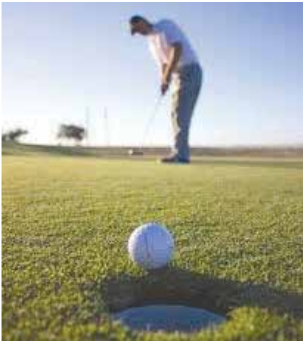
Golf is an excellent summer activity that offers many benefits. Some of the benefits of golf include:
1. A source of physical activity — walking the course, swinging the club, and carrying or pushing the golf bag all contribute to cardiovascular fitness, improved muscle strength, and enhanced flexibility.
2. Cognitive stimulation — the mental engagement involved in playing golf can help enhance cognitive function, memory, and focus, providing a mental workout.
3. Social interaction —golf is a social activity, social interactions contribute to overall happiness, well-being, and a sense of belonging.

4. Stress relief — spending time in nature and engaging in physical activity is known to alleviate stress and improve mood.
While golf has many benefits for most people, the movement that is required of the golf swing is quite complex. It requires proper body alignment, flexibility, strength and requires rotation of the hips, spine, and shoulders. These are common areas for people that tend to get less mobile as we age. When these areas do not move well it changes how our body has to produce the movement, which can lead to injury. Three common areas of injury in golf include the lower back, the shoulders, and the wrist/forearms. Injury can happen for a variety of reasons, including poor mechanics — which can cause excessive stress in unwanted areas, poor mobility — changes how our body tries to move, doing too much too quickly, or failure to warm up before activity. Here are some tips to reduce the chances of injury.
PREVENT A GOLF INJURY WITH THESE 5 TIPS!

1. Perform a proper warm up and stretch before starting your round — this prepares the body for the activity ahead. When our tissues are warm we are less likely to injure something.
2. Practice your swing ahead of time — before the golf season starts take some practice swings — work on your mechanics, gradually build up the number of swings you take. Think of this as conditioning your body for the amount of movement to come.
3. Maintain the mobility of your hips, shoulders, and spine — find a regular mobility routine.
4. Start Slow! Start with 9 holes the first few times out and assess how you feel. If something is sore, get it looked at. Build up to 18 holes, taking days between rounds to give your body time to adapt to the activity.
5. If you have any aches or pain see a Physiotherapist! Physios are movement experts; they can help to assess what might be causing your pain and come up with a plan to address it and keep you golfing.
Seeing a physiotherapist can have many benefits to help you with your golf game. A physiotherapist can help you to reduce any aches/pain, improve your mobility, increase strength, and help to prevent injury in the first place.
If you have any questions about how to prevent injury golfing this summer and want to ensure you stay on the course all summer long, reach out to Megan at Donald Physiotherapy in Davidson — 306- 933-3372. Happy Golfing!
-Megan Lautner

Leave a Reply